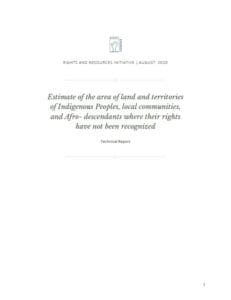Date: September 15, 2020
The global urgency to both document and secure Indigenous Peoples’, local communities’, and Afro-descendants’ customary rights cannot be overestimated. Research shows that legally recognized community lands store more carbon, have lower emissions, and have significantly lower deforestation rates than lands owned by other actors, and cost less to establish and maintain than conventional protected areas. Insecure, contested, and unjust land and forest tenure undermines international efforts to protect, sustainably manage, and restore ecosystems essential to the realization of climate, conservation, and sustainable development goals. The expansion of Indigenous and community-owned and -managed land has emerged as a conservation strategy that is often lower risk, lower cost, and more effective than the conventional, public protected area approach. Yet, in the absence of robust and comprehensive estimates of the land and territories that are customarily managed by Indigenous Peoples, local communities, Afro-descendants, and women within these communities, opportunities for the advancement of rights-based solutions are unlikely to be seized, thus undermining the realization of effective, equitable, and sustainable progress towards key international commitments and national-level priorities.
In 2015, RRI undertook the first global analysis to quantify the amount of land legally recognized by national governments as owned by or designated for Indigenous Peoples and local communities. The study, covering 64 countries comprising 82 percent of global land area, showed that communities legally owned 10 percent of this area and held designated rights to another 8 percent. Yet, some studies suggest that the total area under community management is much greater. Indeed, the leaders of Indigenous, community, and Afro-descendant organizations and expert opinion have long held that communities exercise customary rights on well over 50 percent of the global land mass outside of Antarctica.
This report aims to address this gap by offering a first comprehensive effort to develop a global baseline of the total land area with unrecognized rights of Indigenous Peoples, local communities and Afro-descendants. This analysis draws on previous work, emerging evidence, and expert opinion to begin the process of quantifying the full extent of land to which Indigenous Peoples, local communities, and Afro-Descendants have customarily held rights that have yet to be legally acknowledged by states.
Using validated data points from a sample of 42 countries this analysis covers almost 50 percent of global land area.
As a technical document, this report is succinct and designed to let the data speak for itself. More importantly, users of this report should note that the unrecognized land area of Indigenous Peoples, local communities, and Afro-descendants identified in this study are purposefully conservative, and intended to capture the lower value of estimate-range. The full extent of unrecognized Indigenous, local community, and Afro-descendant lands and territories can be expected to be larger for most if not all of the countries in this study.
The structure of the report is as follows: Section 2 describes the sources and methods used in the report. Section 3 provides the terms and definitions used in the survey. Section 4 presents the global geographical area covered in this report and the quantitative findings. Section 5 presents overall results for each of the 42 countries analyzed. Section 6 details the findings by region (focusing on Asia, Latin America, and Africa). Sections 7 and 8 present the findings of countries participating in the Forest Carbon Partnership Facility and the Carbon Fund programs respectively, both of which
are hosted by the World Bank. Overall conclusions are presented in Section 9. Complete references and supporting end notes are provided at the end of this report.
https://doi.org/10.53892/UZEZ6605

